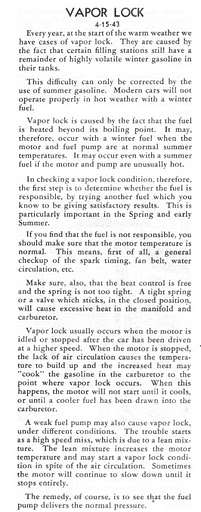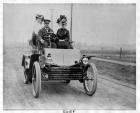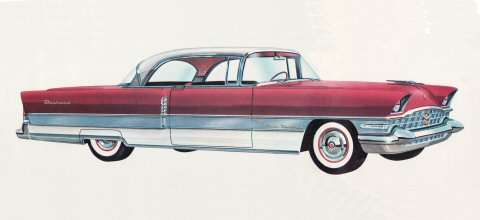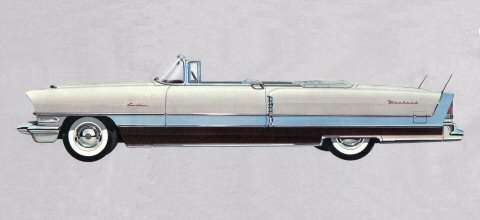|
Re: How clothes pins work to cure "vapor lock"
|
||||
|---|---|---|---|---|
|
Forum Ambassador
|
One of a number of Service Letters dealing with Vapor Lock I've seen in my continuing scanning saga.
Sorry for the image size, technological luddite at work! Attach file:  (23.39 KB) (23.39 KB)
Posted on: 2011/5/29 6:42
|
|||
|
Mal
/o[]o\ ====  Bowral, Southern Highlands of NSW, Australia "Out of chaos comes order" - Nietzsche. 1938 Eight Touring Sedan - SOLD 1941 One-Twenty Club Coupe - SOLD 1948 Super Eight Limo, chassis RHD - SOLD 1950 Eight Touring Sedan - SOLD What's this?  Put your Packard in the Packard Vehicle Registry! Here's how! Any questions - PM or email me at ozstatman@gmail.com |
||||
|
||||
|
Re: How clothes pins work to cure "vapor lock"
|
||||
|---|---|---|---|---|
|
Home away from home

|
Ozstateman. U deserve a Nobel Prize and the $100K prize money for the article u posted.
Everyone else needs to note THE SEVENTH paragraph of the PACKARD FACTORY explanation in the post directly above this post. THe pusher pumps are a great bandaid fix no doubt. BUt i hope that the PACKAR FACTORY DOCUMENTATION listed above will now dispense with the fallacy of, tho theoretically correct, vapor lock occuring between the tank and pump. Edit: ALSO SEE post #7 on page 1 of this thread by PaulK. Read CLOSELY the very TOP sentence on the RIGHT side of the page!!!! IT indicates that the ENGINE heat is heating the gasoline in the tank. I AM NOT FAMILIAR with the PAckard models listed in the documentation of post #7 but that statement from PACKARD FACTORY DOCUMENTAION leads me to belive that the gas tank is a cowl mounted gas tank like early Fords????
Posted on: 2011/5/29 8:15
|
|||
|
VAPOR LOCK demystified: See paragraph SEVEN of PMCC documentaion as listed in post #11 of the following thread:f
packardinfo.com/xoops/html/modules/newbb/viewtopic.php?topic_id=7245 |
||||
|
||||
|
Re: How clothes pins work to cure "vapor lock"
|
||||
|---|---|---|---|---|
|
Home away from home

|
FUrthermore:
Let us come to grips with FUEL PUMPS of FI vs carburetor. THE FI pumps produce much higher pressure than pumps needed for carbs. THAT MEANS that the FI pump is LARGER in overall dimensional size and requires COOLING due to it;s very heavy duty task of providing about 10 times more pressure than a pump for a carb. The FI pump is in most cases controlled by somekind of an ecm. Therfore, the FI pump is mounted INSIDE of the gas tank to COOL THE PUMP (NOT THE FUEL) AND because there is plenty of room in the tank to allow for the FI pump due to it;s relatively enormous size. Therfore the FI pump location in the tank has little to no eng'ring purpose to eleminate vapour lock. THere are other factors.
Posted on: 2011/5/29 8:54
|
|||
|
VAPOR LOCK demystified: See paragraph SEVEN of PMCC documentaion as listed in post #11 of the following thread:f
packardinfo.com/xoops/html/modules/newbb/viewtopic.php?topic_id=7245 |
||||
|
||||
|
Re: How clothes pins work to cure "vapor lock"
|
||||
|---|---|---|---|---|
|
Home away from home

|
Now let us get onto the so-called pusher pumps that so many are installing for older carbureted applications.
NOTE that most everyone thus far that is touting the pusher pump to eleminate vapour lock ONLY ACTIVATES the pusher pump on an OCCASIONAL basis. I know of noone using the pusher pump as a FULL TIME fuel pump on any carbureted engines. (Craig mite be the exception) There is a REASON that the pussher pump crowd only uses the pusher pump OCCASIONALY. They know the reason. But thus far noone will ADMIT to why the pusher pumps are used only intermiitently as opposed to full time fuel pumping. The pusher pumps are a bandaid fix or more accurately a SLEDGE HAMMER fix for vapour lock occuring in the carburetor. Nothing wrong with using an electric fuel pump. I've used them myself. They are often used in pro racing machines too. NOT THE CHeaPY PUMPS. But some of the cheapy electric pumps prodcuing erratic pressure or extremly high pressure over and above the 3 to 7 pounds that a carb can take will prematurely ruin something in carb unless it is regulated. But if the pusher pump is regulated then it's function to overcome the vapour lock may be greatly diminished. BOTTOMLINE: THe pusher pump is only FORCING cooler gasoline into the carb to cool off the carb because the vapour lock is occuring IN THE CARB or lines close to the carb.
Posted on: 2011/5/29 9:11
|
|||
|
VAPOR LOCK demystified: See paragraph SEVEN of PMCC documentaion as listed in post #11 of the following thread:f
packardinfo.com/xoops/html/modules/newbb/viewtopic.php?topic_id=7245 |
||||
|
||||
|
Re: How clothes pins work to cure "vapor lock"
|
||||
|---|---|---|---|---|
|
Forum Ambassador

|
I am unsure if the following is a contribution to the discussion. Most FI pumps I have encountered are quite small by comparison at least the in-tank versions. The old Bosch mechanical and CIS system used on many European car makes had a much larger outside the tank pump as did the later Bosch systems found on Volvos etc which had both a small in tank pre pump and a larger external pump. Fuel pressures in the CIS system were in the 50 PSI range as I recall. Incredible as it may seem the 2003 Ford Crown Victoria Factory Manual states that fuel pump line pressure is 3000PSI and is reduced to 125PSI by the Fuel Regulator before the fuel enters the fuel rail! If this isn't a typo it certainly indicated that vapour lock will never be a problem in modern cars with those kinds of pressures. I admit to having an electric pump on my car as well which I have so far used only for starting after a long sit. I have all the shields in place on the car and have never had a vapour lock issue although I have never been in a parade at 100 degrees either. I recall from my youth that old Ford V-8 flatheads were/are notorious for vapour lock attributed to the fact that the fuel pump was mounted on top back end of the engine. This was possibly the worse place to mount a mechanical fuel pump. Friends of mine who own vintage Ford of the era are running the engines with electric pumps because of the vapour lock problems at even moderate ambiant temps. Modern gas containing ethanol (In Ontario about 5%)is blamed by the owners for exacerbating the problem in old Fords.
Posted on: 2011/5/29 9:24
|
|||
|
______________________________________________
Dave |
||||
|
||||
|
Re: How clothes pins work to cure "vapor lock"
|
||||
|---|---|---|---|---|
|
Home away from home

|
PackardV8 Quote:
BOTTOMLINE: THe pusher pump is only FORCING cooler gasoline into the carb to cool off the carb because the vapour lock is occuring IN THE CARB or lines close to the carb. On what basis do you make this statement? In my engineering opinion, it is WRONG. The vapor lock occurs IN the mechanical fuel pump on the engine. In a liquid (such as today's gasoline) right at, but just below it's "vaporization point" is sucked into the mechanical pump, the fuel pressure necessarily drops. This changes the operational point on the fuel's "phase diagram". The fuel then phases from liquid state to vapor state. Because one of those diaphragm pumps will only pump liquid, not vapor, "vapor lock" (no more pumping of the fuel) occurs. The electric pusher pump increases the line pressure from slightly below atmospheric (on the inlet side of the mechanical pump) to maybe 4PSI (depending on pump and its regulator) above atmospheric pressure. This changes the vaporization point of the incoming fuel so that the fuel does not phase from liquid to vapor, but stays as a liquid, hence eliminating the "vapor lock". Craig
Posted on: 2011/5/29 9:46
|
|||
|
Nuke them from orbit, it's the only way to be sure! Ellen Ripley "Aliens"
Time flies like an arrow. Frui |
||||
|
||||
|
Re: How clothes pins work to cure "vapor lock"
|
||||
|---|---|---|---|---|
|
Home away from home

|
YEs. The point i am trying to make is that any FI pump, regardless of it s location, does not exist for the purpose to eleminate vapor lock. An EFI or FI pump of any type kind, nature, vintage, configuration or any other charcateristic exists for the sole purspose to supply PRESSURE for the FI or EFI.
Therefore, using the theory that the modern fi pump is located in, at or around the gas tank to eleminate vapour lock is only an urban legend for the purpose using a pusher pump on carbureted engines to eleminate vapor lock. The electric fuel pump can be mounted ANYWHERE and stiil provide the BANDAID fix (more like sledge hammer fix ) for vapor lock. What we really need is a way to PREVENT the vapour lock from occuring instead of bandaids to overcome it when it happens IN AT O RAROUND THE CARB. NO vapour lock occurs between engine and gas tank. Addressing any cure for vapour lock betrween engine and gas tank is not addressing the vapour lock problem at all because that is NOT where it occurs. IT occurs in at or around the carb and mechanical fuel pump.
Posted on: 2011/5/29 9:47
|
|||
|
VAPOR LOCK demystified: See paragraph SEVEN of PMCC documentaion as listed in post #11 of the following thread:f
packardinfo.com/xoops/html/modules/newbb/viewtopic.php?topic_id=7245 |
||||
|
||||
|
Re: How clothes pins work to cure "vapor lock"
|
||||
|---|---|---|---|---|
|
Home away from home

|
To add another relevant point, fuel return lines starting being fitted by the various factories in the 1970s, IIRC. Rather than a "dead head" (no return) design like on all our Packards, the return line system circulated the unused fuel back to the a non-vented tank. This caused the incoming fuel temperature to be lower than it otherwise would be as a "dead head".
Also, almost all V-8 designs mount the mechanical fuel pump on the front of the engine so that it is cooled by air being pulled through the radiator by the fan. I'm not sure how much good this does on a hot day, but the air, even at 240F, is cooler than the engine block and metal parts of the fuel pump. Also, some manufacturers on some models used a "deep sump" canister on the bottom of the mechanical pump. I've only see this on "return" style setups. None of these design changes really fix the problem on a very hot day. Even a small electric pusher pump will not fix the problem on one of those days. I have anecdotal data to support this with comparison to an FI fuel pump in the tank, both cars running carbs. Guess which one did NOT make it up a long grade in 110F air? Craig
Posted on: 2011/5/29 9:56
|
|||
|
Nuke them from orbit, it's the only way to be sure! Ellen Ripley "Aliens"
Time flies like an arrow. Frui |
||||
|
||||
|
Re: How clothes pins work to cure "vapor lock"
|
||||
|---|---|---|---|---|
|
Forum Ambassador

|
The reason for mounting a pusher (vane) type pumps near the gas tank is because these pumps typically blow better than they suck or at least that is my understanding.
Posted on: 2011/5/29 10:00
|
|||
|
______________________________________________
Dave |
||||
|
||||
Register To PostTopic is Locked








